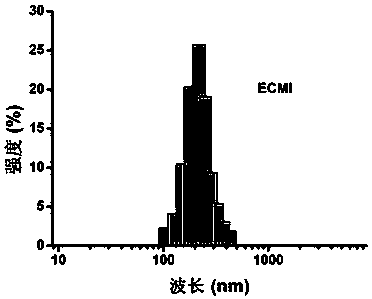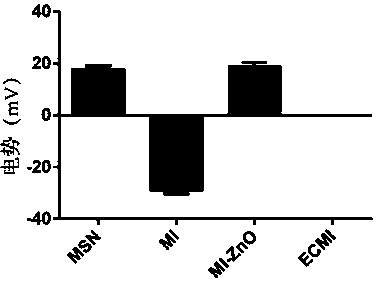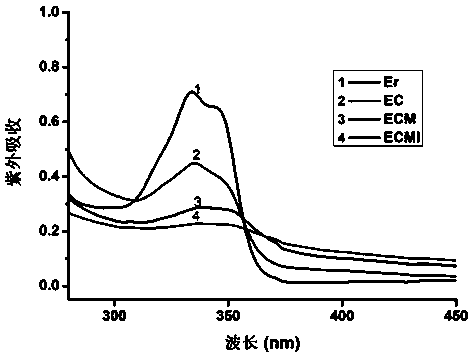Nanometer therapeutic agent with effects of molecule targeting and controllable photodynamic therapy and preparation method and application thereof
A photodynamic therapy and molecular targeting technology, applied in the field of biomedicine, can solve the problems of poor curative effect and increased toxicity
- Summary
- Abstract
- Description
- Claims
- Application Information
AI Technical Summary
Problems solved by technology
Method used
Image
Examples
Embodiment 1
[0040] Measure 20 mL of ultrapure water into a 50 mL round-bottomed flask, add 2.0 g of cetyltrimethylammonium chloride (CTAC), stir at room temperature until completely dissolved, add 0.2 mg of triethanolamine (TEA), and dissolve at 95 Heat and condense in an oil bath at constant temperature and stir for 1 h. Then, 1.5 mL of tetraethylsilane (TEOS) was added dropwise, and then heated, condensed and stirred at a constant temperature in an oil bath at 95 °C for 1 h. The sample was cooled to room temperature, and washed 3-4 times by high-speed centrifugation with absolute ethanol to remove residual reaction reagents. Then collect the samples in 20 mL of washing solvent (0.2 g sodium chloride dissolved in 20 mL of methanol), stir at room temperature for 3 h, wash with high-speed methanol centrifugation for 3-4 times to remove the template agent CTAC, and freeze-dry to obtain white MSN solid powder.
[0041] Take 100 mg of MSN and dissolve them together with 2.5 mL of 3-aminopro...
Embodiment 2
[0043] Take by weighing 600 mg embodiment 1 gained MSN-NH 2 The solid powder was dissolved in 50 mL of methanol, then 5 mg of ICG was added, stirred at room temperature in the dark for 8 h, centrifuged at 10,000 rpm for 10 min, the obtained precipitate was washed three times with ethanol and secondary water, and then the obtained product was freeze-dried, namely Get MI.
Embodiment 3
[0045] Weigh 2.2 g of zinc acetate and 220 mg of magnesium acetate (Zn:Mg=10:1), dissolve in 150 mL of absolute ethanol, heat and stir at 50 °C until they dissolve. Weigh 500 mg of NaOH, dissolve it in 30 mL of absolute ethanol, heat and stir at 70 °C, and cool it in an ice bath after it is completely dissolved, then quickly add it to a flask containing zinc acetate and magnesium acetate, and keep it in an ice bath Under the reaction 8h. After the reaction was completed, n-hexane was added to generate a precipitate. Centrifuge at 8000 rpm for 5 min. Then the solid was dissolved in absolute ethanol again, n-hexane was added, centrifuged again, and the above steps were repeated 3 times, and the obtained product was dried in a fume hood to obtain ZnO QDs.
[0046] Weigh 500 mg ZnO QDs, dissolve them in 75 mL DMF, dissolve them by ultrasonication, then add 250 µL APTES, react at 120 °C for 15 min, centrifuge at 8000 rpm for 5 min, and wash the product 3 times with DMF. The prod...
PUM
| Property | Measurement | Unit |
|---|---|---|
| particle diameter | aaaaa | aaaaa |
| particle diameter | aaaaa | aaaaa |
| particle size | aaaaa | aaaaa |
Abstract
Description
Claims
Application Information
 Login to View More
Login to View More - R&D
- Intellectual Property
- Life Sciences
- Materials
- Tech Scout
- Unparalleled Data Quality
- Higher Quality Content
- 60% Fewer Hallucinations
Browse by: Latest US Patents, China's latest patents, Technical Efficacy Thesaurus, Application Domain, Technology Topic, Popular Technical Reports.
© 2025 PatSnap. All rights reserved.Legal|Privacy policy|Modern Slavery Act Transparency Statement|Sitemap|About US| Contact US: help@patsnap.com



